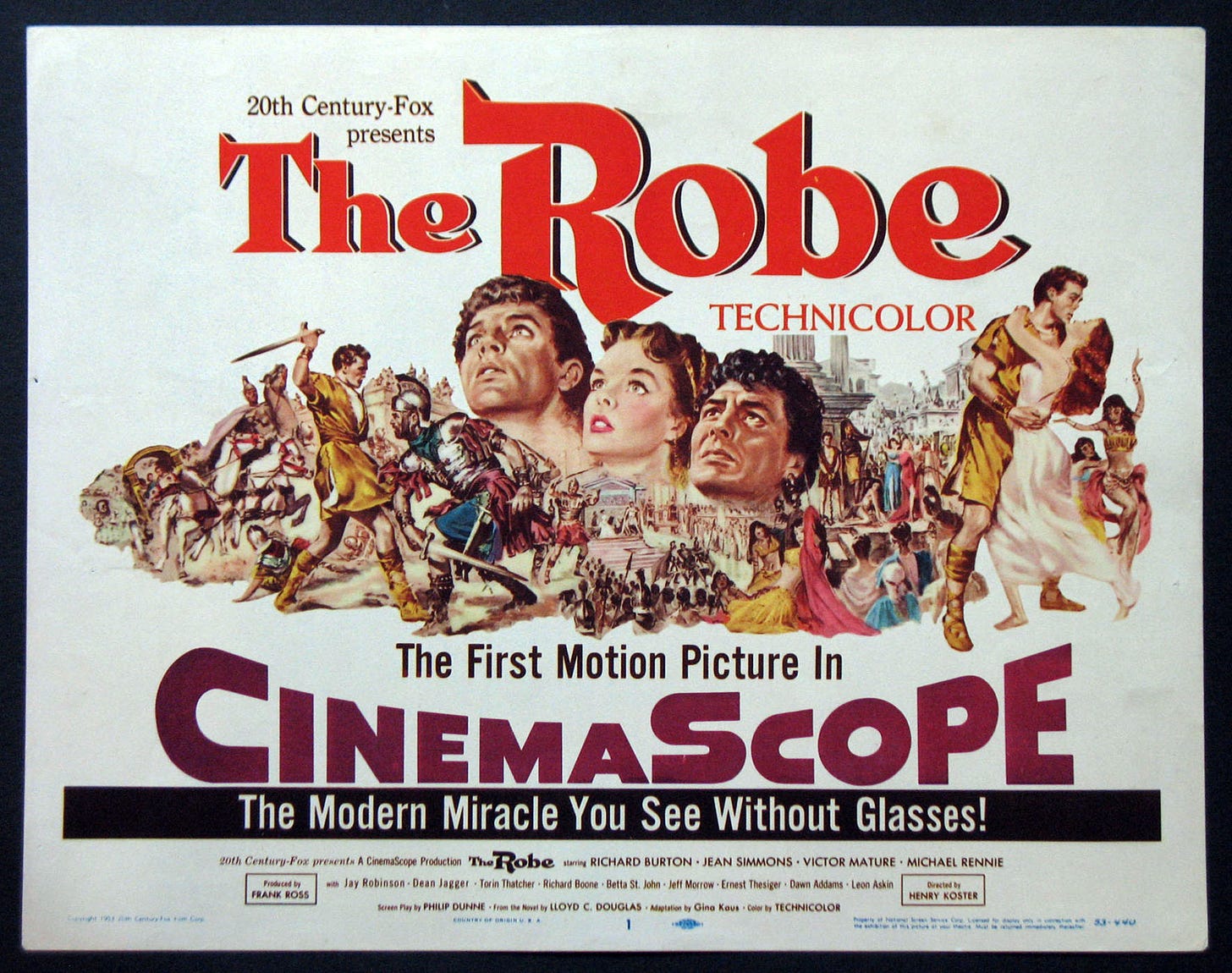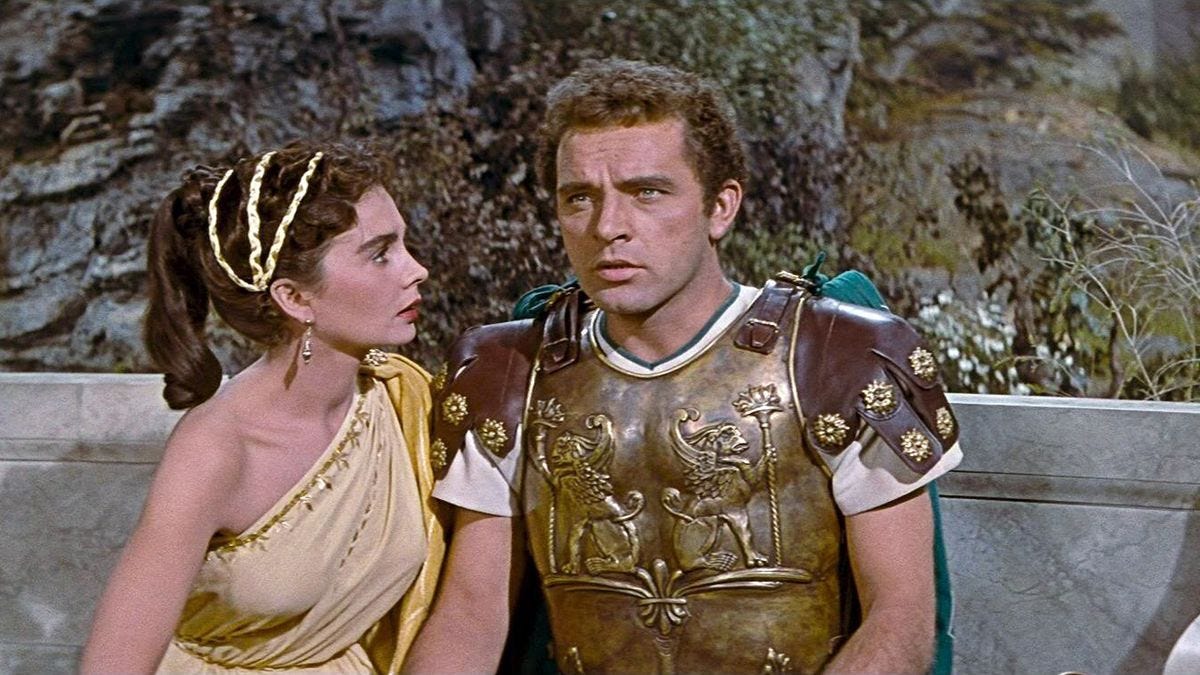'The Robe': The most influential movie nobody watches anymore
in 1953, this Biblical epic introduced CinemaScope, a widescreen format that wowed audiences and changed the movies forever. Now it's the answer to a trivia question.
There are many ways of looking at James Cameron’s Avatar: The Way of Water: as a parable for colonialism, as a plea to respect the environment, and as the latest in the director’s career of innovative special effects works— and, for some, as a kind of cultural paradox. In the years between Avatar and its sequel, a narrative developed, and it’s one that I’ll confess to buying into at times: the original left no “cultural footprint,” it had been tremendously successful but slid from the collective memory, and its sequels would be both unwanted and unsuccessful. Currently, Avatar: The Way of Water is the fourth most financially successful movie of all time and seems poised to move into the third spot, which is currently occupied by another Cameron film, Titanic. (The original Avatar is still hanging out at number one.) Yet the no-cultural-impact takes have persisted even in the face of its undeniable success.
You want to talk about no cultural impact? Take a look at The Robe. A big hit in 1953, it’s virtually forgotten by anyone outside of film circles or under the age of 75 today. Yet, once adjusted for inflation, The Robe is the 52nd highest-grossing film of all time. That puts it ahead of all three Lord of the Rings movies, several Star Warses, Toy Story one through four and a bunch of other movies that are talked about more than The Robe, which isn’t really talked about at all. So, go ahead and point that accusatory finger away from Pandora and point instead to the Roman and Middle Eastern world of The Robe. But you’d be wrong again. Movies that find success on the scale of The Robe, which made over $36 million at the box office (some of it through re-releases in later years) and broke a long, troubling hitless streak at 20th Century Fox, never really disappear — even if they can turn almost invisible.
Like Avatar in 2009, The Robe arrived in theaters touted as both an artistic achievement — “The most inspired story of love and devotion, faith and spectacle, that has ever come to life on screen,” the trailers claimed — and a technological breakthrough. That technological breakthrough: CinemaScope, “the new dimensional photographic marvel you see without glasses!” There had been widescreen processes before CinemaScope, including Cinerama, which premiered the previous year. But Cinerama required a three-projector system and major theatrical modifications. (And, since it was hard to shoot in Cinerama, those who could show films in the format didn’t have much more to show than This is Cinerama.)
CinemaScope, however, required a lens that would translate its anamorphic photography into widescreen. With that and a little training, theaters could give viewers sweeping vistas and enveloping images. Its arrival came just in time, too: movies were losing ground to television and had to offer audiences something they couldn’t get at home. The Los Angeles Times ran a multi-page spread on the film over a month before its premiere with the headline “New Era Dawns With ‘The Robe’.” The accompanying text was equally breathless.
Still, it’s stories, not technical innovations, that draw in crowds and The Robe might have been treated as a novelty if moviegoers didn’t respond to what was going on in that widescreen frame. Adapted from a 1942 bestseller by Lloyd Douglas, a minister turned novelist, the film stars a just-breaking-out Richard Burton as Marcellus Gallio, a Roman tribune who runs afoul of the prince regent Caligula (Jay Robinson) by outbidding him for an educated Greek slave named Demetrius (Victor Mature). For his offense, Marcellus finds himself reassigned to an undesirable new post: Jerusalem.
There he encounters a cult growing around a man named Jesus, whose arrival in Jerusalem coincides with his own. Marcellus is a proud man with a merciful streak; Demetrius was bound for the gladiator pit before he interceded. But when called upon to crucify Jesus, he follows orders, despite the pleas of Demetrius, an early convert. He even gambles on, and wins, the robe Jesus was wearing prior to his execution, a victory with unforeseen consequences that leads to Marcellus’s own conversion and eventual martyrdom.
The Robe takes full advantage of its CinemaScope frame in virtually every shot, an accomplishment made all the more remarkable by director Henry Koster, who was not expecting to shoot the film in the new process until deep in production. Koster, a steady hand who’d worked since the silent era and helmed hits like Harvey and The Bishop’s Wife, fills crowd scenes with extras milling about the streets of Rome and puts the camera squarely in front of charging horses running at full speed. The film, made for $5 million, had to work. Producer Frank Ross had spent a decade trying to shepherd it to the screen, 20th Century Fox was flailing, and movies themselves seemed like they might be in jeopardy. (Hmm…) Mere adequacy wouldn’t be enough.
As a piece of storytelling it’s sometimes light on its feet, sometimes heavy-handed, and sometimes just clunky. In a 1969 interview included on the film’s Blu-ray release, screenwriter Philip Dunne speaks of wanting to avoid the clichés of the genre, like “obvious religiosity” and moments when “Jesus appears on the screen everyone is stunned and overwhelmed.” The finished film kind of does this. Jesus never speaks and is seen from a distance, or obscured by the cross, or as a pair of dangling legs. The film’s middle section focuses not on miracles but on the day-to-day lives (and persecution) of early Christians under the Romans.
The Robe largely stays down-to-earth despite its religious themes, but it also gives Burton some scenes that are virtually impossible to play, like a conversion experience while touching the robe. The final shot, of Marcellus and lifelong love Diana (Jean Simmons) smiling as they walk to their death while the background transforms into a heavenly blue sky is over-the-top enough to make up for any restraint that precedes it. (As the simpering, petulant Caligula, however, Robinson exercises no restraint at all. It's a terrifically fun performance.)
Biblical (and Bible-adjacent) epics were hardly new to moviegoers in 1953, but The Robe offered a blueprint for a new era. The old mix still worked. You could get away with a lot of sex and violence so long as it was packaged piously. But the new widescreen processes — CinemaScope and the competitors that followed — could have been designed specifically to immerse viewers in the past like never before. The Robe produced an immediate sequel in the form of Demetrius and the Gladiators, in which both Mature and Robinson reprised their roles. But its real legacy is the way it blew the door open for the widescreen epics that followed, from The Ten Commandments to Ben-Hur to Spartacus (to say nothing of countless lower-budget sword-and-sandals movies).
Contemporary reviews were largely kind, especially toward the film’s technical achievements, but some were unimpressed even with that aspect. In The Nation, Manny Farber seemed impressed by its “spectacular mural-type photographs in which every detail is clearly defined” but concerned that “the movement of the camera lens is usually a slow sideways one, giving you the impression of looking at the world through a slot-in-the-wall.” His is a measured review, but one with a dagger in its concluding sentence (“reminding me of nothing so much as the worst examples of calendar art”) to match its lede: “This is the age of elephantine, humorless films that show little if any artistic endeavor.” (A decade before “White Elephant Art vs. Termite Art” Farber already had elephants on his mind.) Groucho Marx wasn’t sure, either, saying, in reference to Mature, “No picture can hold my interest when the leading man's bust is bigger than the leading lady’s."
The public, however, disagreed. The Robe played for months, rolling out across the continent after its New York premiere the reappeared in theaters semi-regularly for years. But while some of the films it inspired became institutions, The Robe seemed to lose its cultural foothold. Growing up, I remember it airing occasionally on TV during Sunday afternoons alongside epic als0-rans like Barabbas. Where other films survived widescreen epics going out of fashion, a change in taste undoubtedly hastened by the pan-and-scan era, The Robe mostly became an answer to a trivia question: “What was the first movie released in CinemaScope?”
That’s at once understandable and a little unfair. Watched today, The Robe has a you-had-to-be-there feel to it that even Martin Scorsese’s admiring Blu-ray intro sort of acknowledges. “More than twice as wide as it is high, a completely different mode of vision, at looking at action and space,” he says, recalling watching it as a kid. “That first viewing has always stayed with me, the beauty and wonder of that screen.” But there’s more than just spectacle at work in the film. Elsewhere on the disc, UCLA film professor Jonathan Kuntz notes the resemblance of its final scene to the HUAC hearings, an echo made more resonant by the writing contribution of Hollywood Ten screenwriter Albert Maltz, who went uncredited for decades. Koster, a Jew, fled Germany in the early 1930s and the scenes of Christians forced to flee underground to avoid persecution have a different sort of historic resonance. The culture put its footprints all over the film.
Ultimately it’s hard to imagine how deep and lasting a cultural footprint is anyway. It may have felt like time had washed away Avatar but feelings don’t always match with facts. And if The Robe has faded into semi-obscurity seven decades after conquering the globe (or at least North America, which was better equipped to exhibit CinemaScope films in 1953), the relics of that conquest can be seen scattered about in the films that continued what it started. Its influence can be seen in the work of countless filmmakers who saw the world it opened up and wanted to explore it for themselves.






I know it's always perilous to try to presume intent on behalf of writers, but do you think the "no cultural impact" takes persist because of the bubble effect? People thinking the reactions of their circle of friends is representative of the average person? "No one in my Twitter feed is obsessing about Avatar so it has no cultural impact." Even though something like only 20% of Americans are on Twitter and an even smaller percentage post regularly, and an even smaller percentage than that post about movies. But journalists are MUCH more present and active on Twitter than the average person.
The flip side of this are articles I've read bemoaning how some films revered in online film circles flop even though they're clearly pretty audience unfriendly.
It’s fascinating that this mode of Christian movie fell out of favor to be replaced by cheap pandering Shlock like everything Kirk Cameron makes and...slightly more expensive schlock like BREAKTHROUGH or that movie where Jennifer Garner’s kid falls down a tree.
I bet you anything that if someone tried to make a film with the same approach to Jesus as The Robe--I.e. not really showing him at all--it’d be vilified by the pureflix crowd